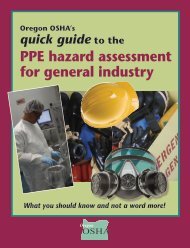Technical Manual - Section 3 (Safety Hazards)
Technical Manual - Section 3 (Safety Hazards)
Technical Manual - Section 3 (Safety Hazards)
You also want an ePaper? Increase the reach of your titles
YUMPU automatically turns print PDFs into web optimized ePapers that Google loves.
D. OBSERVATIONS, DIRECTIONS, AND<br />
CONCLUSIONS<br />
VISUAL OBSERVATIONS<br />
There are characteristic visual observations that can serve as<br />
indicators of rig stability. They include, but are not limited<br />
to, the following:<br />
@<br />
@<br />
@<br />
@<br />
@<br />
The foundation supports the rig, substructure, and all<br />
applied loads while in an operational mode, without<br />
excessive movement. Basically in a level and plumb<br />
configuration.<br />
No large movement is observable between the mast<br />
support structure and the rotary/setback support<br />
structure when the slips are set and the load is<br />
removed from the mast, or vice versa.<br />
The empty travel block hangs plumb with the<br />
centerline of the wellbore and the mast support<br />
structure remains level.<br />
The mast support structure and/or substructure does<br />
not lean to one side more than the other when the<br />
load is applied. The guywire on one side becomes<br />
noticeably taut while the guywire on the opposite<br />
side becomes slack.<br />
The guywire anchor(s) show(s) no visible signs of<br />
movement during the loading and unloading of the<br />
system while in operational mode.<br />
The chart presented in Figure III:1-5 may be used as a guide<br />
to the pretensioning of guywires. This method is commonly<br />
referred to as the Catenary Method (guywire sag method).<br />
SUPPORT MANUAL<br />
The support manual, entitled Guideline on the Stability of<br />
Well Servicing Derricks, is divided into work sections and<br />
intended<br />
to supplement this chapter. It provides a detailed analysis of<br />
existing guides and standards along with state-of-the-art<br />
developments.<br />
<strong>Section</strong> 3 provides the direction and guidance necessary to<br />
evaluate and select the proper system to assure rig stability.<br />
<strong>Section</strong> 4 discusses the installation of guywire anchor<br />
systems. It is extremely important to point out that stability<br />
is dependent on the entire system, and not on a single<br />
component.<br />
In the absence of support documentation or manufacturer<br />
specifications, <strong>Section</strong> 6 sets forth the criteria for performing<br />
effective pull testing. It further identifies what would be<br />
acceptable in lieu of actual pull testing.<br />
CONCLUSION<br />
No set of observations or recommendations should be so<br />
restrictive or subjective as to preclude the use of innovative<br />
approaches to derrick stability systems. Properly designed<br />
substructures and base beams have been used effectively and<br />
safely as anchorages for guywires.<br />
Engineering calculations based on sound engineering<br />
principals may also be used as evidence of an acceptable<br />
alternative to pull testing. Dead weight of equipment,<br />
fabricated components (i.e., padeyes) and other<br />
appurtenances are all considerations in determining rig<br />
stability.<br />
The derrick manufacturer's specifications and<br />
recom-mendations should be the preferred and primary means<br />
of determining derrick stability.<br />
Guywire anchors, newly installed according to the<br />
manufacturer's specifications, may be used without the<br />
III:1-5
















